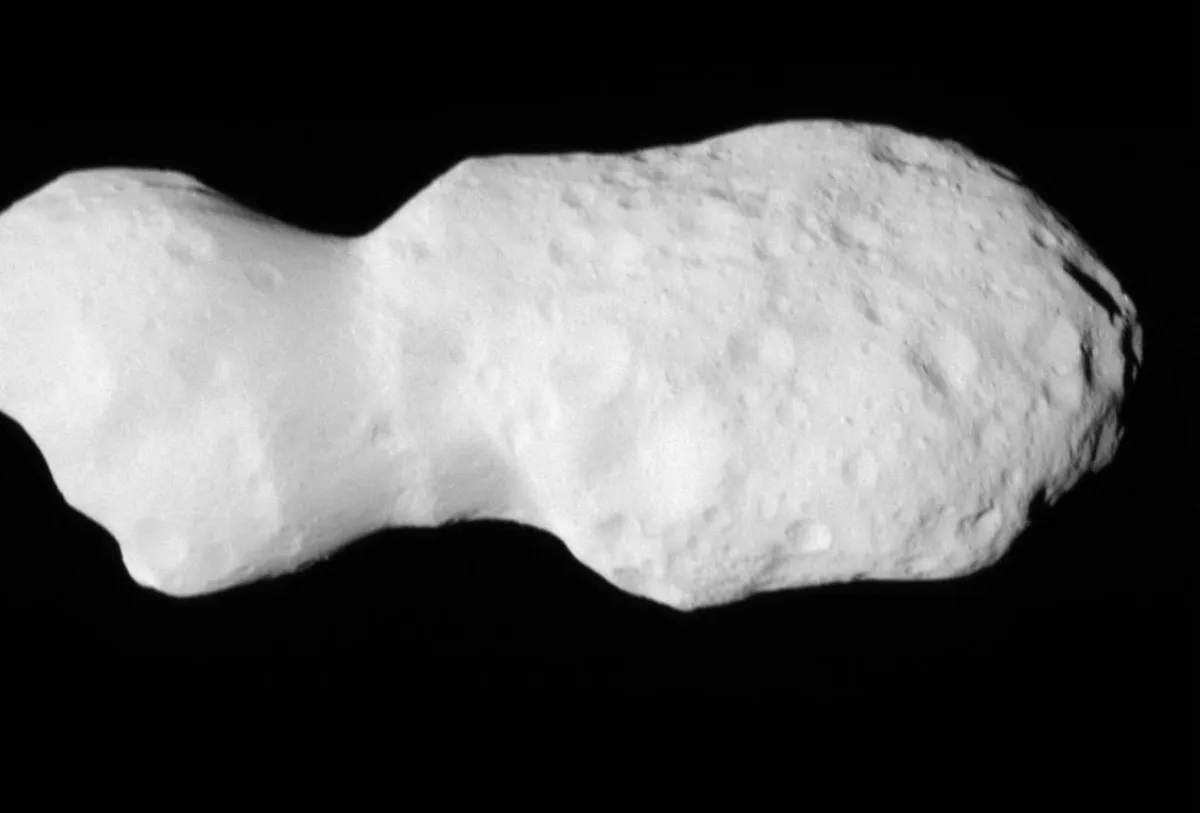
In a remarkable achievement for space exploration, NASA’s Lucy spacecraft has successfully conducted its second asteroid encounter, capturing breathtaking images of a uniquely shaped fragment of an asteroid that formed approximately 150 million years ago. The spacecraft flew within 600 miles (960 km) of the asteroid known as Donaldjohanson on April 20, 2025, marking a significant milestone in our understanding of the early solar system.
During its close approach, the Lucy spacecraft began transmitting images that confirm some of the team’s initial expectations. The first set of images revealed that Donaldjohanson is likely an elongated contact binary—a type of celestial body formed when two smaller objects collide. The team, however, was taken aback by the peculiar shape of the narrow neck connecting the two lobes of the asteroid, which resembles two nested ice cream cones. “Asteroid Donaldjohanson has strikingly complicated geology,” remarked Hal Levison, principal investigator for the Lucy mission at the Southwest Research Institute in Boulder, Colorado.
Levison emphasized the importance of studying the complex structures of Donaldjohanson, stating, “As we study the complex structures in detail, they will reveal important information about the building blocks and collisional processes that formed the planets in our Solar System.” Preliminary analysis from the spacecraft's L’LORRI (Lucy Long Range Reconnaissance Imager) indicates that the asteroid is larger than initially estimated, measuring about 5 miles (8 km) in length and 2 miles (3.5 km) in width at its widest point.
It’s worth noting that the full asteroid is not completely visible in the initial images, as its size exceeds the imager’s field of view. The Lucy team anticipates that it will take up to a week to downlink the remaining encounter data from the spacecraft, providing a more comprehensive picture of the asteroid’s shape and structure. Similar to Lucy’s first target, Dinkinesh, Donaldjohanson is not a primary science target of the Lucy mission; rather, the Dinkinesh flyby served as a systems test, while the current encounter is a full dress rehearsal involving extensive observations for maximum data collection.
In addition to L’LORRI, the Lucy spacecraft is equipped with other sophisticated scientific instruments, including the L’Ralph color imager and infrared spectrometer, as well as the L’TES thermal infrared spectrometer. Data from these instruments will be retrieved and analyzed over the coming weeks, allowing scientists to delve deeper into the geological features of Donaldjohanson.
For the remainder of 2025, the Lucy spacecraft will continue its journey through the main asteroid belt. The mission's first major target, the Jupiter Trojan asteroid known as Eurybates, is set to be encountered in August 2027. “These early images of Donaldjohanson are again showcasing the tremendous capabilities of the Lucy spacecraft as an engine of discovery,” stated Tom Statler, program scientist for the Lucy mission at NASA Headquarters in Washington. “The potential to really open a new window into the history of our solar system when Lucy gets to the Trojan asteroids is immense.”
The NASA Goddard Space Flight Center in Greenbelt, Maryland, oversees overall mission management, systems engineering, and safety assurance for the Lucy mission, while also designing and building the L’Ralph instrument. Hal Levison from the Boulder office of SwRI leads the science team, observation planning, and data processing. The spacecraft, constructed by Lockheed Martin Space in Littleton, Colorado, is designed to navigate its orbital trajectory with the assistance of Goddard and KinetX Aerospace. The Johns Hopkins Applied Physics Laboratory in Laurel, Maryland, developed the L’LORRI instrument, while Arizona State University designed and built the L’TES spectrometer.
Lucy represents the thirteenth mission in NASA’s Discovery Program, managed by NASA’s Marshall Space Flight Center in Huntsville, Alabama. As the Lucy spacecraft continues to unveil the mysteries of the solar system, it promises to enhance our understanding of the celestial bodies that shape our cosmic neighborhood.